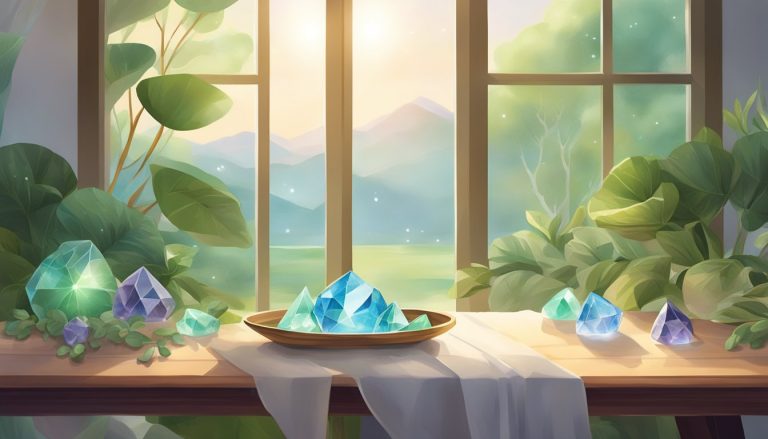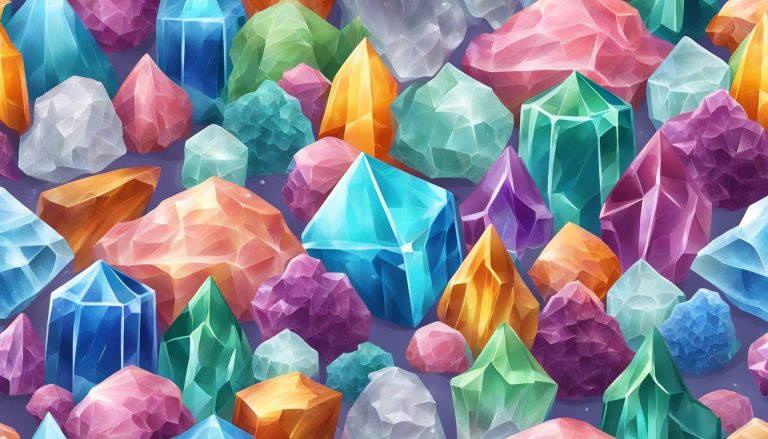What Crystals Cannot Go in Water? A Quick Guide
Are you someone who finds solace in the mystical world of crystals? If so, you may be familiar with the practice of using water to cleanse and purify these precious stones.
It’s important to note that not all crystals are suitable for immersion in water.
Understanding their composition and hardness is crucial in determining whether or not this cleansing method is safe.
Crystals possess unique spiritual and healing properties, making them highly sought after by enthusiasts.
Water is often used as a natural and effective way to cleanse these crystals, but caution must be exercised.
Certain crystals contain minerals and metals that can react adversely with water, potentially causing damage or altering their properties.
Hence, it becomes imperative to know which crystals can safely interact with water.
Another factor to consider is the Mohs Hardness Scale, which measures a mineral’s resistance to scratching.
Crystals with a lower ranking on this scale may be more susceptible to damage when immersed in water.
By understanding the composition and hardness of your crystals, you can ensure that your cleansing practices align with their unique needs, allowing you to fully benefit from their spiritual and healing energies.
Quick Summary
Whether you’re a crystal enthusiast or someone seeking to explore their metaphysical properties, it’s crucial to exercise caution when using water as a cleansing method.
By understanding the compatibility of your crystals with water and considering their mineral composition and hardness, you can safely embark on your journey of spiritual enlightenment and healing with these beautiful treasures from the Earth.
Key Takeaways
- Not all crystals can be safely immersed in water for cleansing purposes.
- Understanding the composition and Mohs Hardness Scale of your crystals is crucial in determining whether or not they can be safely cleaned with water.
- It’s important to research and understand the properties of your crystals before attempting any cleansing or purification methods.
Contents
Understanding Crystals and Water
When it comes to cleansing and purifying crystals, water is one of the most popular methods. However, not all crystals can be safely cleansed in water. Understanding which crystals can and cannot go in water is essential to preserving their integrity and ensuring safe application in various practices.
Crystals are made up of various minerals and elements, and some of these components can react negatively with water. It’s important to note that not all crystals are created equal, and what works for one crystal may not work for another.
Water-safe crystals like Clear Quartz, Rose Quartz, Amethyst, and Citrine are part of the Quartz family and can be cleansed in water without issue. However, there are many crystals that should never be put in water, as they can become damaged or even toxic.
Some examples of crystals that cannot go in water include:
- Sulfur
- Antimony
- Copper
- Asbestos (fibrous form)
- Iron
- Aluminum
- Zirconium
It’s important to note that there may be other chemicals and elements found in some crystals that can also cause harm. Therefore, it’s never worth trying to cleanse a crystal in water if you’re unsure of its composition.
In addition to the potential harm to the crystal, using water to cleanse certain crystals can also affect their energetic properties. For example, some crystals may absorb water and become heavy, while others may lose their shine or lustre.
Overall, it’s important to do your research and understand the properties of your crystals before attempting to cleanse them in water.
When in doubt, it’s always best to err on the side of caution and use alternative cleansing methods, such as smudging or placing the crystals in sunlight.
The Mohs Hardness Scale
When it comes to determining which crystals can and cannot go in water, the Mohs hardness scale is an important tool to understand. This scale rates minerals from 1 to 10 based on their scratch-resistance and hardness, with 1 being the softest and 10 being the hardest.
For crystals that are safe to go in water, mineral experts recommend sticking with those that are a 6 or higher on the Mohs hardness scale. These minerals are generally considered to be water-safe and will not dissolve or crack if left in water for an extended period of time.
However, it’s important to note that crystals with a hardness rating of 5 or below should not be put in water. These minerals can dissolve or crack if left in water for too long, and should be kept away from water altogether.
Some crystals that contain minerals that can rust or release toxins in water should also be avoided. This includes minerals such as pyrite and hematite, which should not be submerged in water.
Overall, it’s important to understand the Mohs hardness scale when working with crystals and water. By sticking with minerals that are a 6 or higher on the scale, you can ensure that your crystals remain safe and intact when submerged in water.
Crystals That Should Not Be Immersed in Water
When it comes to cleansing crystals, water is a popular choice. However, not all crystals can be safely immersed in water. Here are some crystals that should not be submerged in water:
- Selenite: This crystal is made of gypsum, which is a soft mineral that can dissolve in water. Selenite is also very fragile and can easily break or dissolve in water.
- Calcite: Calcite is a soft mineral that can dissolve in water. It can also be damaged by water, which can cause it to lose its lustre.
- Lodestone (Magnetite): This crystal is an iron ore and can rust when exposed to water. It is also naturally magnetized, which can be affected by water.
- Halite (Rock Salt): This crystal can dissolve in water, which can cause it to lose its shape and structure.
- Tangerine Quartz: This crystal can be damaged by water, which can cause it to lose its colour and lustre.
- Red Coral: This organic gemstone can be damaged by water, which can cause it to lose its colour and lustre.
- Soft Crystals: Crystals that are soft, such as talc, can be easily damaged or dissolved by water.
It’s important to note that while some crystals may be safe to use in water for short periods, prolonged exposure to water can cause damage. When in doubt, it’s best to avoid immersing your crystals in water and use other cleansing methods instead.
Safe Ways to Cleanse Crystals
When it comes to cleansing your crystals, it’s important to know which methods are safe and effective. While some crystals can be cleansed with water, others can be damaged or even dissolve in water. Here are some safe ways to cleanse your crystals:
Smudging with Sage
One popular method for cleansing crystals is smudging with sage. To do this, light a bundle of dried sage and let it burn for a few seconds before blowing out the flame. Hold your crystal in the smoke for a few minutes, allowing the smoke to surround and cleanse the crystal.
Grounding in Earth
Another method for cleansing crystals is to bury them in the earth. This method is particularly effective for grounding and centering your crystals. Simply bury your crystal in the earth for a few hours or overnight, then dig it up and wipe it clean.
Running Water
While not all crystals can be cleansed in water, many can be safely rinsed under running water. This method is particularly effective for cleansing crystals that have been used for healing or meditation. Simply hold your crystal under running water for a few minutes, visualising the water washing away any negative energy.
Saltwater
Saltwater is another effective method for cleansing crystals, but it’s important to note that not all crystals can be cleansed in saltwater. To safely cleanse your crystals with saltwater, mix a tablespoon of sea salt with a cup of water and place your crystal in the solution for a few hours. Rinse the crystal under running water and dry it with a soft cloth.
Full Moon
Cleansing your crystals under the light of a full moon is another effective and safe method. Simply place your crystals outside under the light of a full moon for a few hours or overnight. This method is particularly effective for charging your crystals with positive energy.
Remember, when it comes to cleansing your crystals, it’s important to use safe and effective methods. By following these tips, you can keep your crystals cleansed and energised for all your spiritual needs.
Potential Damage to Crystals
When it comes to cleansing and purifying crystals, water is a popular choice for many crystal enthusiasts. However, not all crystals can tolerate exposure to water. In fact, some crystals can suffer severe damage when exposed to water. Here are some of the potential damages that can occur to your crystals when exposed to water.
Colour Loss
Some crystals can lose their colour when exposed to water. This is because water can dissolve the minerals that give the crystal its colour.
For example, Amethyst can lose its purple colour when exposed to water, and Citrine can become paler or even clear.
Polish Damage
Water can also damage the polish on some crystals. This is because water can dissolve the wax or oil used to polish the crystal. For example, the polish on Selenite can become dull or even dissolve when exposed to water.
Irreversible Damage
Some crystals can suffer irreversible damage when exposed to water. This is because water can cause the crystal to break, chip or even dissolve. For example, Malachite can develop cracks or even dissolve when exposed to water.
To avoid damaging your crystals, it is essential to know which crystals can and cannot be exposed to water. Refer to the provided search results for a list of crystals that should not be exposed to water.
Crystals Safe for Water Cleansing
If you’re looking to cleanse your crystals with water, it’s important to know which ones are safe to use. Here are some crystals that are water-safe:
- Clear Quartz: This crystal is a great option for water cleansing. It’s a member of the Quartz family and is known for its clarity and ability to amplify energy.
- Rose Quartz: Another member of the Quartz family, Rose Quartz is a popular crystal for love and emotional healing. It’s also safe to use in water.
- Agate: This crystal comes in a variety of colours and patterns, and is known for its stabilising and grounding properties. It’s safe to use in water and can help promote emotional balance.
- Jasper: Jasper is a versatile crystal that comes in many different colours and patterns. It’s known for its grounding and protective properties, and is safe to use in water.
- Moonstone: This crystal is associated with the moon and is said to help with intuition and emotional balance. It’s safe to use in water and can help promote a sense of calm.
- Carnelian: This crystal is known for its energising and creative properties. It’s safe to use in water and can help promote motivation and courage.
- Obsidian: This dark, volcanic glass is known for its protective properties. It’s safe to use in water and can help absorb negative energy.
Remember to always do your research before using any crystal in water. Some crystals, like Malachite and Calcite, should be avoided as they can sustain irreversible damage when exposed to water.
Understanding Crystal Elixirs
Crystal elixirs are a popular way to incorporate the healing properties of crystals into your daily routine. They are easy to make and can be used for a variety of purposes, from promoting relaxation to boosting energy levels.
To make a crystal elixir, you simply place a crystal in water and let it sit for several hours or overnight. The water absorbs the energy and vibration of the crystal, creating a potent elixir that can be ingested or used topically.
However, not all crystals are safe to use in water. Some crystals contain toxic substances that can leach into the water, making it unsafe for consumption. It is important to know which crystals are safe to use in water and which ones are not.
Here is a list of crystals that should not be used in water:
- Malachite
- Selenite
- Celestite
- Lepidolite
- Halite
- Pyrite
- Hematite
- Magnetite
- Chrysocolla
These crystals can be harmful when ingested, so it is best to avoid using them in elixirs.
On the other hand, there are many crystals that are safe to use in water, such as:
- Clear Quartz
- Amethyst
- Rose Quartz
- Citrine
- Smoky Quartz
- Black Tourmaline
- Green Aventurine
- Blue Lace Agate
- Carnelian
When making a crystal elixir, it is important to use a glass or ceramic container, as some crystals can react with metal or plastic. You should also clean your crystals thoroughly before using them in elixirs, to remove any dirt or debris.
In conclusion, crystal elixirs are a powerful way to incorporate the healing properties of crystals into your daily routine. However, it is important to use caution when selecting crystals to use in water, to avoid any potential harm. By following these guidelines, you can create safe and effective elixirs that promote health and wellbeing.
The Impact of Crystal’s Composition
When it comes to determining whether a crystal can go in water or not, one of the most important factors to consider is the crystal’s composition. Some crystals contain metals such as iron and copper, which can rust and corrode when exposed to water. Others may contain sulfur, lead, asbestos, or other toxins that can be harmful if leached into the water.
It’s important to note that not all crystals are created equal. Some crystals are harder and more durable than others, and can withstand exposure to water without any issues. However, softer crystals may be more susceptible to damage, discoloration, or structural changes when exposed to water.
To help you determine whether a crystal can go in water or not, here’s a table summarizing some of the most common metals and toxins found in crystals, along with their potential impact on the crystal when exposed to water:
| Substance | Potential Impact on Crystal when Exposed to Water |
|---|---|
| Iron | Can rust and corrode, changing the crystal’s appearance and structural integrity |
| Copper | Can corrode and change the crystal’s appearance and colour |
| Sulfur | Can cause the crystal to break down and lose its lustre |
| Lead | Can leach into the water and be harmful to humans and animals |
| Asbestos | Can release harmful fibres into the water and air |
| Toxins | Can leach into the water and be harmful to humans and animals |
In general, if a crystal contains any of these substances, it’s best to avoid exposing it to water. However, if you’re unsure whether a crystal is safe to use in water, it’s always best to err on the side of caution and consult a crystal expert or do further research before proceeding.
Final Thoughts
Now that you know which crystals cannot go in water, you can take better care of your precious stones. Remember, not all crystals are created equal, and some may be more fragile than others.
It’s important to keep in mind that crystals have healing properties and can absorb negative energy. Water is a powerful tool for cleansing, but it’s not always the best option for your stones.
When it comes to healing, it’s essential to choose the right crystals for your needs and intentions. Each crystal has a unique vibration and can help with different aspects of your life.
If you’re unsure about whether a crystal can go in water or not, it’s always best to err on the side of caution. You don’t want to risk damaging your crystal or losing its healing properties.
In conclusion, taking care of your crystals is crucial to ensure they continue to work their magic. By understanding which crystals cannot go in water and how to cleanse them properly, you can keep your stones in optimal condition and reap the benefits of their healing properties.
Frequently Asked Questions
Which crystals should not be placed in water?
Not all crystals are safe to use in water. Some crystals can be toxic or can dissolve in water, which can damage the crystal or make the water unsafe to drink.
Crystals that should not be placed in water include Selenite, Halite, Desert Rose, Pyrite, Lepidolite, Malachite, and Azurite.
Can all crystals be placed in water?
No, not all crystals can be placed in water. Some crystals can dissolve or become damaged when exposed to water.
It’s important to research each crystal before placing it in water to ensure that it is safe to use.
What are the risks of putting crystals in water?
The risks of putting crystals in water include damaging the crystal, contaminating the water, or ingesting toxic substances.
It’s important to research each crystal before using it in water and to use caution when creating crystal elixirs or infusions.
What are some alternatives to cleansing crystals with water?
Some alternatives to cleansing crystals with water include smudging with sage or palo santo, placing the crystal in sunlight or moonlight, burying it in salt or soil, or using sound vibrations.
It’s important to research each cleansing method before using it to ensure that it is safe for the crystal.
Are there any crystals that can be damaged by water?
Yes, some crystals can be damaged by water. Crystals that are porous, soft, or contain metals should not be placed in water.
Examples include Selenite, Halite, Pyrite, Lepidolite, Malachite, and Azurite.
What crystals are safe to use in water for plants?
Crystals that are safe to use in water for plants include Clear Quartz, Amethyst, Citrine, Rose Quartz, and Green Aventurine.
These crystals can help promote growth and vitality in plants. It’s important to research each crystal before using it in water for plants to ensure that it is safe and effective.






